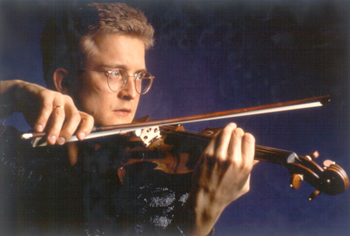by Daniel Hathaway

Other violinists who concoct Bach-inspired programs like this one would probably start off with music by Bach himself. Not Tetzlaff, who immediately seized everyone’s attention with Ysaÿe’s striking Sonata in g, Op. 27, No. 1. One of the composer’s six solo sonatas dedicated to famous violinists, each reflecting their personal style, this one was dedicated to Joseph Szigeti, for whom Bartók wrote his Rhapsody No. 1 — thus providing a link to the fourth composer on the program.
Beginning with a warm, ingratiating tone, Tetzlaff reacted, chameleon-like, to Ysaÿe’s abrupt color changes. The tortuous lines of the opening movement soon morphed into spooky tremolos, surprisingly tonal chords, and, at the end of the second-movement fugue, a dramatic cadenza. Tetzlaff made the Allegretto as amiable as its tempo marking suggests, and his playing in the finale was compellingly rhythmic. By the end of the piece, the violinist had visited every dynamic level from chapel-filling fortes to audible pianissimos.
Bach’s Sonata No. 3 in C almost seemed as forward-looking as the Ysaÿe with its surprising dissonance in the opening Adagio. Tetzlaff expertly layered the voices of the fugue, bringing out its climax and shining a light on its unexpected unison episode. The Largo was lovely, the Allegro assai perhaps a bit more “molto” than “assai,” but fluent and wonderfully light on its feet. At the end, Tetzlaff let its final phrase float into Finney’s rafters like a wisp of smoke.
Tetzlaff understandably took a brief pause of ten minutes before continuing with six pieces from the violin volume of György Kurtág’s grab-bag of miniatures, Signs, Games and Messages (1987-2005). Lasting nine minutes in all, these half-dozen vignettes paid homage to J.S.B., memorialized Tamás Blum (the Hungarian conductor), celebrated others of the composer’s friends, or just explored abstract musical ideas. Irregular meters, sad double stops, keening on open strings, and a crazy inner dialogue are among the effects Kurtág uses in these over-in-a-flash pieces, and Tetzlaff whole-heartedly embraced each of them.
Just as Ysaÿe’s Sonata that opened the program connected to Bartók, so Bartók’s Sonata for Unaccompanied Violin connects to Bach’s C-Major Sonata: Bartók wrote it after hearing Yehudi Menuhin play the Bach work in 1943 and took the inspiration for his first movement from the great Ciacona of Bach’s d-minor Partita.
A lot of that inspiration gets overshadowed by Bartók’s own strong musical personality, and Christian Tetzlaff didn’t shy away from that factor. The fugue was brutal, nearly crazed. Melodia was beautifully ruminative, its muted middle section redolent of mysterious night sounds. The Presto was busy — and buzzy — with its swinging tune, and acerbic quarter-tones and ponticello passages. Tetzlaff was thoroughly impressive, not the least when he twice played left-hand pizzicatos while turning pages with his bow hand. As compelling to watch as to listen to, Tetzlaff ended with the kind of final, triumphant gesture that had characterized his easy sense of showmanship all evening.
After all that superb violinistic drama, a cathartic encore was in order. Tetzlaff gave the audience a simple but luminous parting gift: the Andante from Bach’s second Sonata.
Published on ClevelandClassical.com November 3, 2015.
Click here for a printable copy of this article



